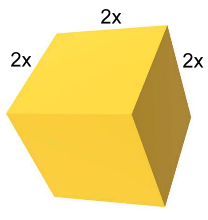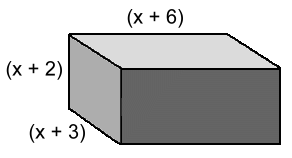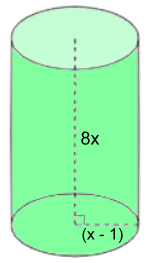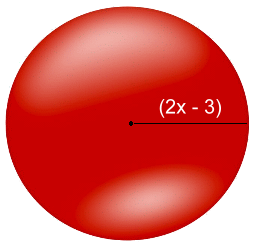 The problems on this page combine what you know about volume and surface formulas with your knowledge about how to simplify polynomials. You should try the problems on your own, and then use our solutions to check your answers. Before looking at the problems on this page, you might want to review:
Problem 1: Find the volume and surface area of the cube  Volume = L3
Volume = L3V = L · L · L V = (2x)(2x)(2x) V = 8x3 Surface Area = 6·L2 SA = 6(2x)2 SA = 6(4x2) SA = 24x2 Problem 2: Find the volume and surface area of the rectangular prism 
Volume = L·W·H V = (x + 2)(x + 3)(x + 6) V = (x + 2)(x2 + 9x + 18) V = x3 + 9x2 + 18x + 2x2 + 18x + 36 V = x3 + 11x2 + 36x + 36 Surface Area = 2·L·W + 2·L·H + 2·W·H SA = 2(x + 2)(x + 3) + 2 (x + 2)(x + 6) + 2(x + 3)(x + 6) SA = 2(x2 + 5x + 6) + 2(x2 + 8x + 12) + 2(x2 + 9x + 18) SA = 2x2 + 10x + 12 + 2x2 + 16x + 24 + 2x2 + 18x + 36 SA = 6x2 + 44x + 72 Problem 3: Find the volume and surface area of the cylinder  Volume = πr2H
Volume = πr2HV = π(x - 1)2(8x) V = π(x2 - 2x + 1)(8x) V = π(8x3 - 16x2 + 8x) Surface Area = 2πr2 + 2πr·H SA = 2π(x - 1)2 + 2π(x - 1)(8x) SA = 2π(x2 - 2x + 1) + 2π(8x2 - 8x) SA = π(2x2 - 4x + 2) + π(16x2 - 16x) SA = π(2x2 - 4x + 2 + 16x2 - 16x) SA = π(18x2 - 20x + 2) [Notice that it isn't necessary to multiply in the π] Problem 4: Find the volume and surface area of the sphere  Volume = (4/3)πr3
Volume = (4/3)πr3V = (4/3)π(2x - 3)3 V = (4/3)π(2x - 3)(2x - 3)(2x - 3) V = (4/3)π(2x - 3)(4x2 - 12x + 9) V = (4/3)π(8x3 - 24x2 + 18x - 12x2 + 36x - 27) V = (4/3)π(8x3 - 36x2 + 54x - 27) [Here we leave both the fraction and the π unmultiplied] Surface Area = 4πr2 SA = 4π(2x - 3)2 SA = 4π(4x2 - 12x + 9) SA = π(16x2 - 48x + 36) |